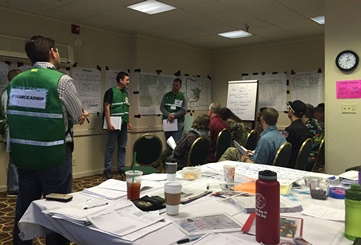Southeast Regional Office, Atlanta, Georgia
Cohesive Strategy - Response to Wildfire, Maintain and Restore Resilient Landscapes
Collaboration is the Key

NPS Photo
The National Park Service (NPS) Southeast Regional Office (SERO) recently hosted an interagency, interdisciplinary session of Intent into Action: Advanced Leadership for the Command & General Staff in Chattanooga, Tennessee. Attendees from around the country representing a variety of disciplines and federal agencies came to gain practical skills and tools to build cohesion, adaptiveness and resilience during complex incident planning and operations.
NPS staff from the Alaska, Intermountain, Midwest, National Capital, Northeast and Southeast regions represented a wide range of programs from administration and maintenance to law enforcement and wildland fire. Members of the US Forest Service National Incident Management Organization (NIMO) and the US Fish & Wildlife Service (FWS) also attended.
Southeast Regional Fire Management Officer Shawn Nagle, who played a key role in the course’s organization, celebrated the deliberate mix of participants. "The diversity of backgrounds and disciplines from the students made this course successful. There were NPS and FWS, wildland fire and all hazard, east coast to Alaska, and regional level to field level, which proved how ICS [Incident Command System] is a management system that works across all boundaries."
The Intent into Action training was made possible through collaborative planning efforts and financial assistance from the SERO Wildland Fire and Aviation Management Program, the Washington Office (WASO) Visitor and Resource Protection Directorate and the NPS Branch of Wildland Fire’s Workforce Development Grant.
The NPS Wildland Fire Workforce Development Grant Program is intended to promote succession, encourage innovation, build technical skills and provide opportunities for interdisciplinary and interagency collaboration. National Wildland Fire Training Program Manager Jim Shultz endorsed the training as an example of the grant’s purpose. “The delivery of the L-481 course in the Southeast Region clearly represents an effort which exemplifies the foundational elements of the program. It is through these kinds of activities that the grant program will continue to see support.”
Large incidents are complex and require degrees of teamwork and integration beyond smaller incidents. Command and General Staff (C&G) members must perform as a cohesive unit to conduct effective operations under a shared vision and understanding. This program concentrates on integrating leadership and incident management acumen to achieve strategic results in large-scale incidents, and ensuring the C&G can meet objectives from using incident management practices.
The high-intensity, five-day program develops proficiency beyond the nominal requirements of the Incident Command System (ICS). The training satisfies the requirements for Type 2 C&G staff positions as per NWCG and the Department of Interior (DOI) Incident Positions Qualification Guide (IPQG).
As overseer of emergency law and order (ELO) requests for NPS events and incidents, WASO Chief of Law Enforcement, Security and Emergency Services Charles Cuvelier sees an additional benefit of these types of training.
“We have consistently observed there is a direct relationship to the decisions made by teams and costs associated with incidents. Opportunities such as this training provide a means to create key decisions, integrate them in planning, and then execute the intent into action. Good decisions, well executed, protect parks, people, and resources in a cost effective way. The opposite is true as well. This training hones the skills of our incident management teams to better them for the circumstances in which they are sent to our parks in a time of need.”
All participants improved their skills in decision-making during time-critical situations, communication with a range of stakeholders, and leading and motivating people. The course provided practical experience using ICS structure in the context of a large incident response.
Upon completion of the course, 15 NPS personnel became C&G qualified, but more importantly, interagency and interdivision relationships were built or strengthened, and will provide endless benefits to all agencies and programs represented at the training.
Contact: Joshua Manley, Regional Fire Communication and Education Specialist
Email: e-mail us
Phone: (215) 327-6407
Last updated: December 14, 2017
